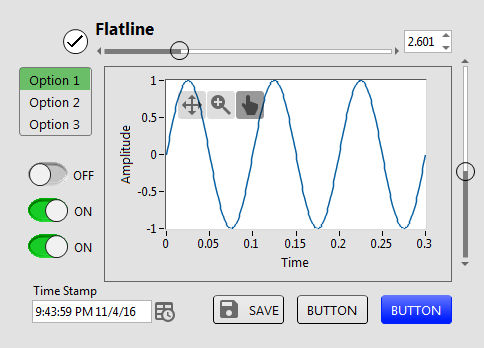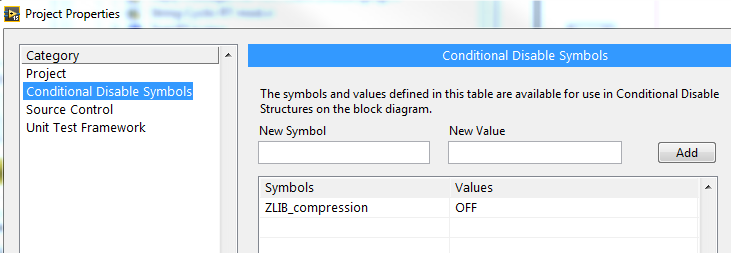-
Posts
1,986 -
Joined
-
Last visited
-
Days Won
183
Content Type
Profiles
Forums
Downloads
Gallery
Everything posted by drjdpowell
-
View File Flatline Controls A set of custom controls, following the trend of a more flat UI design. Heavily influenced by Google’s Material Design, though constrained by what can be done with available tools and options in LabVIEW. Uses icons from Google Material Design. — Buttons based on the system booleans (with hover effects). Icons can be added as decals (such as from materialdesignicons.com) — Matched sets of controls for numeric/string/enum/etc., based on Silver controls, but swapping out all ‘chrome’ for simple boxes and lines. — flattened versions of switches/sliders/arrays/graphs etc. Now on the LabVIEW Tools Network JDP Science Tools group on NI.com. Submitter drjdpowell Submitted 06/13/2016 Category User Interface LabVIEW Version 2011 License Type BSD (Most common)
-
Version 1.9.1
1,791 downloads
A set of custom controls, following the trend of a more flat UI design. Heavily influenced by Google’s Material Design, though constrained by what can be done with available tools and options in LabVIEW. Uses icons from Google Material Design. — Buttons based on the system booleans (with hover effects). Icons can be added as decals (such as from materialdesignicons.com) — Matched sets of controls for numeric/string/enum/etc., based on Silver controls, but swapping out all ‘chrome’ for simple boxes and lines. — flattened versions of switches/sliders/arrays/graphs etc. Now on the LabVIEW Tools Network JDP Science Tools group on NI.com. -

messenger library Instructional videos on YouTube
drjdpowell replied to drjdpowell's topic in Application Design & Architecture
I didn’t notice the MAX install part, so that might be my problem. Thanks. -

messenger library Instructional videos on YouTube
drjdpowell replied to drjdpowell's topic in Application Design & Architecture
Here is my current RT version of the example project (to go with the newest version of Messenger Library). To run the actor manager on the RT, you'll need to add it to the project (its in <LabVIEW>/project/Messenger Library).Messenger Library RT Test 2015.zip -
Sorry guys, I was on holiday when Stobber asked his question. Rolf has answered better than I could. I have only used polling to identify changes. I tend to have timestamped data with the timestamp as primary key, and getting MAX() of the primary key is very fast. One could also use triggers to increment some field whenever something of interest changes, and then poll that field.
-

How to increase performance on lage configuration INIs?
drjdpowell replied to flowschi's topic in OpenG General Discussions
That 15-30 sec figure, at 1.5 to 3 ms per line, seems an order of magnitude too slow to me.- 7 replies
-
- variantconfig
- configuration ini
-
(and 2 more)
Tagged with:
-

messenger library Instructional videos on YouTube
drjdpowell replied to drjdpowell's topic in Application Design & Architecture
I've just got the evaluation kit for an sbRIO with RT Linux. I ran the example with 'Instrument' on the sbRIO; I found that the OpenG zlib compression library did not deploy to RT Linux. So I had to disable zlib with the following Project Conditional Disable: ZLIB_Compression == OFF Otherwise I didn't make any modifications. But I (so far) have not been able to get my custom probes working on RT, so I'm investigating other RT-usable tools. -- James -

How to increase performance on lage configuration INIs?
drjdpowell replied to flowschi's topic in OpenG General Discussions
OpenG was written before proper recursion existed in LabVIEW, and uses (slow) VI-Server calls to dive into clusters. MGI is more recent and uses proper recursive calls, so should be significantly faster. Personally, I use JSON for configuration files.- 7 replies
-
- variantconfig
- configuration ini
-
(and 2 more)
Tagged with:
-

Dynamically launch VI can't pass DVR to caller
drjdpowell replied to Stobber's topic in LabVIEW General
Why are you not just (plain-old synchronously) calling the subVI?- 8 replies
-
- dvr
- dynamic_vi
-
(and 1 more)
Tagged with:
-

Dynamically launch VI can't pass DVR to caller
drjdpowell replied to Stobber's topic in LabVIEW General
References are “owned” by the "VI hierarchy" that created them, and are automatically destroyed if that hierarchy goes idle. Asynchronously-called VIs run in their own independent hierarchy (even if you use the Run method instead of ACBR). In your example, the DVR was destroyed when the launched VI finished.- 8 replies
-
- dvr
- dynamic_vi
-
(and 1 more)
Tagged with:
-
You could extend your Action Engine to have a “Register” action, which takes a User Event and saves it in an array internally, then posts to the Event whenever the config value changes. Then processes loops can register if they need to be informed when something has changed. Then you have a hybrid AE/messaging system.
-
What are you meaning by a “thread” here? Users don’t create threads.
-

LabVIEW 2010 compatibility
drjdpowell replied to Nicola Cesca's topic in Code Repository (Certified)
No, because you didn’t identify what package you want. -
Added to 1.8.1 version now in the CR. Please test it for me.
-
Sure, Ben. I haven’t needed such thing (yet) so I hadn’t put it in. Is it just the number of elements in the queue that you need?
-

Question about Write Panel to INI__ogtk.vi
drjdpowell replied to kgaliano's topic in OpenG General Discussions
Some refs are static; they always exist and you are neither creating or destroying them. “This VI†and control refs are of this type. “Closing†these refs is a no-op. Other refs are both dynamically created and involve holding resources open of some kind (like an open file, or a Queue or something). Here is where one worries about ‘memory leaks’. -
Basically a function call on a server. Used for controlling the server. “Calibrateâ€, “Measure Sampleâ€, etc.
-

Question regarding Error Wire in some OpenG subVIs
drjdpowell replied to kgaliano's topic in OpenG General Discussions
The speaker who called it an anti-pattern was Dmitry, at the recent CLA Summit in Berlin. I don’t think he posts on LAVA, but I suspect he might argue that calling code should decide if “data being dropped†is acceptable or not and thus either dropped data should be an error (with calling code forced to decide what to do) or it should be a separate output, such as a “data dropped†boolean, which calling code should immediately either handle or explicitly choose to ignore. -

Question about Write Panel to INI__ogtk.vi
drjdpowell replied to kgaliano's topic in OpenG General Discussions
The VI ref was created by the calling code, and the calling code is responsible for closing it if/when it needs closing. If I were updating this VI, I might add a “VI ref out†output to visually prompt the developer to deal with the ref. -

Question regarding Error Wire in some OpenG subVIs
drjdpowell replied to kgaliano's topic in OpenG General Discussions
Many LabVIEW developers don’t use warnings, and I recently saw a talk where they were described as an “anti-pattern†(a common software design that has more negatives than positives and should be avoided). You are right though, that a toolkit like OpenG shouldn’t be dropping warnings that pass through it.




